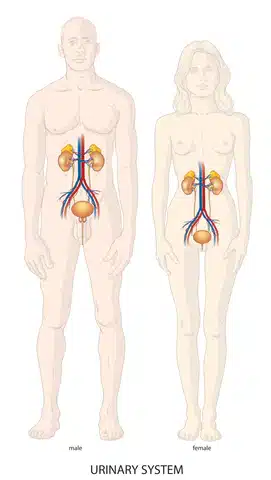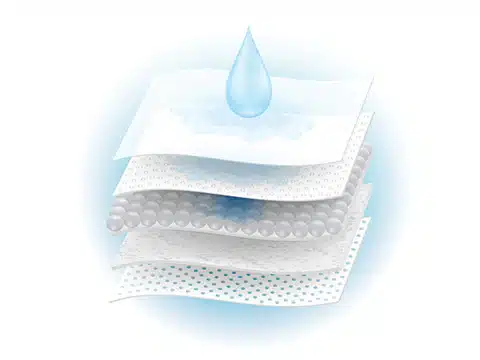Those who live with urinary incontinence often struggle with their conditions. So the last thing you want is another urinary tract condition on top. A crucial part of incontinence care is keeping yourself or your loved on clean and comfortable to prevent infections. This includes UTIs. UTIs are common throughout the population but incontinence increases the risk of developing a UTI, which can lead to further complications. Today we are going to discuss what a UTI is, what the symptoms are, how to treat a UTI and, of course, how to prevent them.

What is a UTI?
A UTI or urinary tract infection is when part of the urinary systems, including the bladder, urethra, and/or kidneys, becomes infected. UTIs occur when bacteria from the genital, vaginal or anal areas travel to the bladder. Women are at a particular risk as they have shorter urethras than men.
Lower UTIs occur when the organs in the lower urinary tract (the bladder and urethra) become infected. Whereas an upper UTI occurs when the infection spreads to the kidneys. This can cause serious complications, including permanent damage that reduces kidney function. The bacteria can also spread to other organs, which means it’s important to catch UTIs as soon as possible.
There is a wide range of causes for UTIs including:
- Sexual intercourse
- Poor hygiene
- Diabetes
- Catheter use
- Kidney stones
- Obesity
- Blocked urine flow
- Difficulty emptying bladder
- Scented feminine products
- Incontinence
As a result, it is critical, if you have incontinence, that you regularly change into clean materials and products, and fully clean yourself if an accident occurs. If you care for someone with incontinence, regularly checking if they need product changing and are properly cleaned after an accident. Doing so helps prevent the spread of bacteria and skin irritation.

Symptoms of Urinary Tract Infection
UTI pain occurs due to abdominal cramps and burning during urination. You may also experience the need to frequently urinate or the constant urge to urinate. When urinating, you may find you can only release a small amount of urine at a time. You may also feel fatigues or dizzy, and your urine may be cloudy, bloody or smell bad. Fever, chills or nausea can also indicate the infection has reached the kidneys.
In senior patients, if a UTI is left untreated, symptoms can include:
- Weakness
- Nausea
- Confusion
- A sudden increase in incontinence symptoms
Treatment for UTIs
If you suspect you have a urinary tract infection then you need to see a doctor. They will take a urine test to confirm the presence of bacteria that is causing the UTI. The doctor can then prescribe an antibiotic to kill the bacteria. You should always remember to finish the cycle of prescribed medication.
In some cases, if the pain is intense, pain medication may be described. You can also take NSAIDs (non-steroidal anti-inflammatory drugs) to help reduce inflammation, fever and pain.
Home Remedies for Urinary Tract Infections
Prescribed medication is important for the treatment of UTIs, especially in those with incontinence. However, there are some home treatments you can use alongside the prescribed antibiotics.
Vitamin C
Some studies have found that that Vitamin C increases the acidity of your urine. This helps kill off bacteria that cause UTIs. Vitamin C can be ingested as a tablet or in fruits and vegetables like kiwi, oranges and capsicum.
Probiotics
In order to maintain a healthy balance of bacteria in the gut, probiotics help promote beneficial microorganisms. A common probiotic strain that some studies link to the prevention of UTIs is Lactobacillus. This can be found in yogurt, some cheeses, kefir and supplements.

How to Prevent UTIs in Incontinence Patients
You can help prevent UTIs by maintaining proper hygiene and making a few simple changes. This includes adopting a healthier lifestyle. If your incontinence products get soiled, change them immediately. Pull up adult diapers, especially, can hold faecal matter close to the urethra, which makes it easier for bacteria to spread. If you are a carer for an incontinence patient, you need to check them regularly to ensure they don’t sit in soiled products.
Always remove your incontinence products from front to back, and wipe from front to back to avoid spreading bacteria. Use a gentle and unscented soap to wash yourself or loved one after an accident. Make sure you keep the area dry after cleaning as bacteria grows in moist areas.
You should invest in breathable incontinence products that are moisture wicking, to avoid the growth of bacteria. When possible, make sure you reach the toilet in time, or that the person you are caring for reaches the bathroom.
Avoid constipation by focusing on a diet rich with fibre and nutrients. This means plenty of wholegrains, fruits and vegetables. Remain hydrated as fluids can help flush out bacteria.
Looking for the right products to help protect yourself from leaks or accidents due to incontinence? Explore the range of products by Holistic Incontinence. We also carry a skincare range, to help you stay clean when dealing with accidents!
